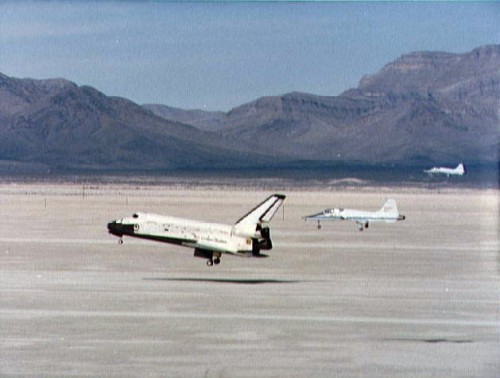
More than three decades ago—and two full years ahead of the first shuttle launch—NASA took the unusual step of picking a great white blotch of compacted salt and gypsum in New Mexico’s Tularosa Valley as a potential landing strip for the reusable spacecraft. Even before the first flight of Columbia, it had long been planned for the primary end-of-mission landing sites to be Edwards Air Force Base, Calif., and, later, the Kennedy Space Center, Fla. However, the tertiary site of White Sands, selected by NASA in March 1979, offered near-perfect weather, all year round, and a vast runway, which provided ample margins of safety. In March 1982, that safety net was called upon for the first and only time in shuttle history … and supported a landing which caused more than a few hearts to jump into throats.
White Sands is an enormous place. Its size and color make it virtually unobstructed and visible from space. It lies in a mountain-ringed region called “Alkali Flats” and was first employed by Northrop Aviation in the 1940s to test military target drones. It quickly acquired the nickname “Northrop Strip,” which later became corrupted into “Northrup Strip,” following a typo on a press release. The new name stuck, and by 1952 “Northrup” had become part of White Sands Missile Range, with a pair of 6.6-mile-long runways crossing each other in an X shape. During the first two shuttle missions in 1981, it was held in reserve in case an emergency demanded an immediate return to Earth after the first orbit. “Should the orbiter not be in a safe orbit,” noted a NASA press release, “the spacecraft would be slowed down by a de-orbit burn, high over the South Pacific, east of Samoa. The flight path would cross Baja California and the Mexican state of Senora, until the spacecraft was in the denser atmosphere and the crew would fly it, ‘dead-stick,’ into Northrup Strip.”
Sounds simple? It wasn’t.
In fact, right up until the very end of the shuttle era, White Sands remained on NASA’s list of contingency landing sites, and pilot astronauts frequently and routinely honed their skills there. Although it only saw one orbiter—Columbia on STS-3 in March 1982—touch down on its hard-packed runway surface, the area almost saw service a second time in December 2006, when the returning crew of Discovery on STS-116 were temporarily thwarted in their efforts to land by poor weather at both Edwards and the Kennedy Space Center. (Ultimately, they landed at Edwards, eliminating the program’s last hope that White Sands might again host one of the nation’s finest flying vehicles.)
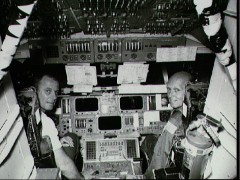
Like the crew of STS-116 which followed it, the astronauts of STS-3 were not supposed to land in New Mexico at all. In fact, launched into orbit on 22 March 1982, theirs was a scheduled seven-day flight to demonstrate the shuttle’s capabilities as a platform for scientific experiments. During their time aloft, Commander Jack Lousma and Pilot Gordon Fullerton evaluated Columbia’s robotic arm and supported a multitude of payloads, devoted to a variety of disciplines from plant seeds to space science. Even before launch, however, their landing site carried a big question mark. Officially, they would touch down on Runway 23 at Edwards, but unseasonal rain showers had left it under several inches of water. Four days before STS-3 set off, hoping to err on the side of caution, NASA called up White Sands as a backup option.
By an enormous stroke of ill-fortune, and despite having 90-percent near-perfect weather all year round, White Sands was battered by its worst wind and sand storm in 25 years … on the very day that Lousma and Fullerton were due to land there, 29 March. Based in New Mexico at the time, supporting the landing, was “rookie” astronaut Charlie Bolden—today’s Administrator of NASA—who recalled the storm for an oral history interview. “This dust storm was unlike anything I’d ever seen,” Bolden recalled. “It’s gypsum and it’s very fine, like talcum powder. Everything was covered in plastic, the windows were sealed, but it didn’t make any difference. That was a hint that this was not a good place to land the shuttle!”
Early on the 29th, less than half an hour before their de-orbit burn, Mission Control advised Lousma and Fullerton that conditions at Edwards were unacceptable … and the situation at White Sands offered no alternative but to remain aloft for another 24 hours. For the astronauts, it was an opportunity for a little extra time in weightlessness. “It was terrific,” remembered Fullerton in his NASA oral history. “We watched the world and I wouldn’t have had it any other way. In fact, we flew right over White Sands, with the nose pointing straight down, and I could see this monster storm going on there. It looked like it was headed for Texas!” In Fullerton’s mind, the decision to wave-off both Edwards and White Sands was the only logical choice.
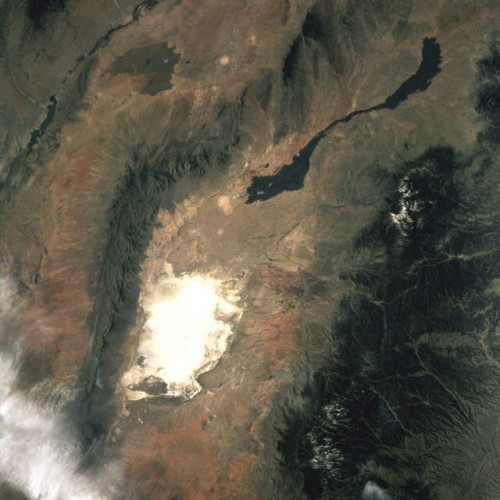
Meanwhile, Chief Astronaut John Young—veteran of the first shuttle mission—had flown several weather reconnaissance sorties over the New Mexico site and reported that conditions were far from optimum for STS-3 to land. Sand drifts had even blown into the public affairs area and gathered against the sides of buildings, reaching depths of two feet or more in places. “The runway got eroded by the wind,” recalled Grady McCright, the White Sands facility manager, in his NASA oral history, “so we had people driving a road grader that night to grade it, compact it, and get it ready for landing the next morning. The wind didn’t quit blowing until dark that night.”
By daybreak on 30 March 1982, the storm had subsided and Lousma and Fullerton resumed their preparations for re-entry into the atmosphere, bound for White Sands. As Columbia descended, the view through the windows mirrored the effect of a blast furnace. “It was an early-morning landing,” Fullerton recalled, “meaning that the main part of the entry is at night.” The glow of ionized particles all around the vehicle was particularly striking. Continuing to fall, Columbia passed over Edwards Air Force Base, heading straight for the mountains of New Mexico. At an altitude of 10,000 feet, Lousma activated the “autoland” system, which NASA hoped to use on later missions, before taking manual control at 500 feet for the final approach to White Sands’ Runway 17.
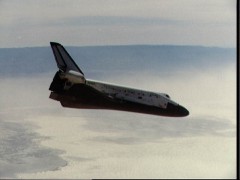
After so many years preparing for this moment, there was no chance that a seasoned pilot would allow a computer to land for him … and Lousma was one of the few shuttle pilots not to hold test-pilot credentials. (He became an astronaut in April 1966 and was never selected for either Air Force school at Edwards or the Navy school at Patuxent River, Md.) Other astronauts knew this, but they also knew that a lack of formal test-pilot credentials did nothing to detract from being a top-notch aviator; after all, Gene Cernan, the last man on the Moon, had no test-piloting background, either. “Jack’s a great guy,” remembered Fullerton. “He’s not a test pilot, but a very capable guy and a great guy to work with. I couldn’t have done better to have a partner to fly with.”
Flying the shuttle into White Sands and executing a manual landing was not the only worry. “The crews were very concerned that they had everything that they can at their control to make sure it goes well,” explained Arnold Aldrich, later head of the Space Shuttle Program at NASA Headquarters in Washington, D.C., “and what they worried about was not that the autoland system wouldn’t fly the vehicle right, [but] if there was some glitch in the autoland system right at a critical point of approach and they had to take control back over.” Getting off the autoland and back onto manual control might pose dynamic problems which could not easily be handled in a timely fashion.
Charlie Bolden, who had followed the development of the shuttle’s flight software, was also unhappy about using autoland so close to touchdown, especially on a test flight such as STS-3. “We developed the procedures that we would use for autoland,” he said, “how they would manually take over at the very last second and go ahead and land the vehicle. We recommended this was not a good thing to do. You’re asking a person who’s been in space to take over in this dynamic mode of flight and land the vehicle safely. Their physical gains, their mental gains, their balance; everything’s not there. Not a smart thing to do, but the decision was made that we really need to demonstrate this, so we’re only going to go to 500 feet anyway.”
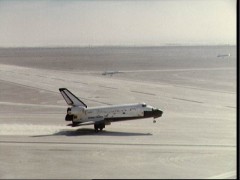
It was decided, before launch, to use airspeed, rather than altitude, as a cue to deploy Columbia’s landing gear. The wheels began to lower about 100 feet above the runway, but took longer than anticipated; they were only fully locked into position a mere two seconds before the shuttle touched down. To observers, it was truly nail-biting to see the shuttle streaking in to land at 200 miles per hour, with her gear still in the process of coming down. Thankfully, the landing was successful, although NASA would revert to using altitude, rather than airspeed, as a cue on future missions. On STS-3, the effect was that Columbia touched down more than half a mile past the runway threshold and required Lousma to apply differential braking to keep the vehicle close to the centreline. Although the vertical impact velocity of both the main and nose gears were within mission rules, it was still far harsher than expected and caused a gash-like scrape in one of her tyres, a cracked rotor in one of her brakes, and extensive contamination by billowing gypsum dust.
So fine was the dust that it quite literally saturated the spacecraft and caused extensive damage which was not fully resolved in time for her next flight … or, indeed, for the rest of Columbia’s career. “I flew it several flights later,” recounted Charlie Bolden, “on my first flight and when we got on orbit, there was still gypsum coming out of everything! They thought they had cleaned it … but it was just unreal what it had done!”
STS-3’s exact landing time was 9:04 a.m. Mountain Standard Time (11:04 a.m. in Florida and 10:04 a.m. in Houston, Texas) on Runway 17, setting a new shuttle record of eight days in orbit. As the gypsum-coated vehicle sped down the strip, with her forward gear in the process of rotating down to the ground, the nose pitched suddenly, and unexpectedly, back into the air. This gave observers a moment or two with hearts in throats. Even the landing commentator’s calm, professional voice seemed laden with surprise as he counted down the number of feet to nose gear down and full weight on wheels: “Touchdown … Nose Gears … ten [feet] … five … four … three … ,” when all at once the nose sprang back up. He paused for a moment, repeated himself—“ … Three … ”—and then, when the nose finally jolted its way harshly down and slapped onto the runway, “Touchdown!”
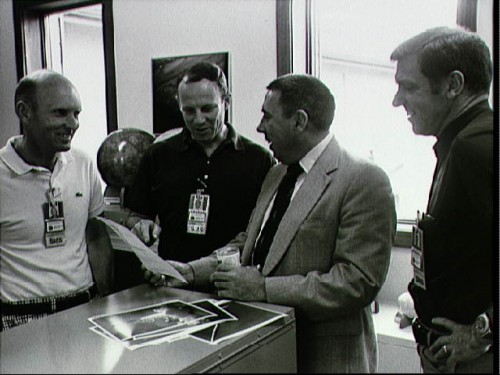
The effect, as Fullerton would relate, was “a kind of wheelie.” The astronauts were trying to prevent what they thought might be a premature touchdown of the nose wheels. “It pointed out another flaw … in the flight software. The gains between the stick and the elevons, that were good for flying up in the air, were not good when the wheels were on the ground. [Jack] kinda planted it down, but then came back on the stick and the nose came up. A lot of people thought this is a terrible thing, but we improved the software and so people don’t do that anymore, but we discovered a susceptibility.” In spite of concerns expressed by NASA managers at the time, STS-3 was still a test flight, as well as only the third voyage of the world’s most advanced spacecraft. The achievement was that the astronauts identified the problem before the shuttle became operational, and additional simulator runs by the STS-4 crew would use the 200-foot altitude mark, rather than airspeed, as their cue to deploy the landing gear. The key point to be made was that STS-3 was safe and successful.
Charlie Bolden watched the landing attentively. “Everything seemed to be going well until just seconds before touchdown, when all of a sudden we saw the vehicle kinda pitch up and then kinda hard-nose touchdown. We found out that, just as Jack Lousma had trained to do, you need to move [the stick] an appreciable amount [to disengage the autoland]. We didn’t realise that. The way he had trained was just to do a manual download with a stick. When he did that, he disengaged the roll axis on the shuttle, but he didn’t disengage the pitch axis, so the computer was still flying the pitch, although he was flying the roll. Gordon Fullerton just happened to look at the eyebrow lights and he noticed that he was still in auto in pitch. He told Jack, and so Jack just kinda pulled back on the stick and it caused the vehicle to pitch up. Then he caught it and put it back down and he saved the vehicle.”
As servicing vehicles swarmed around Columbia, the spacecraft sat motionless on the runway, in Fullerton’s words, “surrounded by white gypsum.” So severe was the damage that the flow rate from the purge units attached to the forward fuselage had to be increased and the aft compartment’s vent doors were closed to prevent further contamination. On hand at White Sands to greet the astronauts, in addition to their families, were New Mexico Governor Bruce King and former Apollo astronaut Jack Schmitt, as well as the missile range’s commanding officer, Major-General Alan Nord.
Shortly afterwards, the orbiter was towed to a huge crane, known as the Stiffleg Derrick, which, with the assistance of a conventional crane, hoisted Columbia atop the Boeing 747 Shuttle Carrier Aircraft for the return trip to Florida. On the afternoon of 6 April 1982, following a refuelling stop at Barksdale Air Force Base, La., she arrived back home on the East Coast. Had she returned to Edwards, as originally planned, her return to Florida was not anticipated before 9 April. This contributed in part to an earlier launch of her final test flight, STS-4, from July 1982 into the last week of June. Her early return to the Cape, though, was something of a double-edged sword for shuttle engineers. On the one hand, it allowed NASA’s management—who were, by now, becoming increasingly confident in the reusable spacecraft’s abilities—to bring the STS-4 launch forward, but on the other hand it was alarmingly clear that she was not in good shape and would need extensive, and expensive, repairs before she could fly again.
As Charlie Bolden had remarked, Columbia was saturated with gypsum dust and, despite sterling efforts to remove it, the powdery stuff would remain in small quantities, hidden in nooks and crannies, for the rest of her career. It was quite astonishing, therefore, that the “flow” in the Orbiter Processing Facility to meet a late-June launch target was accomplished in just 42 days! This represented a significant reduction from the 610 days needed to prepare STS-1, the 104 days needed for STS-2, and the 68 days for STS-3. It seemed that NASA was making headway in its efforts to get the shuttle ready to fly. Launches every two weeks were still a long way off and it seemed doubtful that they would be achievable. The technical challenges in preparing payloads for flight and tending to the spacecraft and its thermal protection system were almost overwhelming. Even at its peak flight rate in 1985, the year before NASA lost its first orbiter and crew, only nine missions were accomplished in a single 12-month period. By 2002, the year before Columbia herself was lost in the second shuttle disaster, that figure had fallen to just six flights.
http://www.youtube.com/watch?v=dDvyznX1ipY
Video Credit: NASA
With the benefit of hindsight, it was naïve to suppose that a vehicle of such complexity could ever come close to becoming the spaceflying equivalent of a commercial airliner. Yet that was precisely the intention … a dream which would persist to 1986 and beyond. In fact, NASA’s final shuttle manifest, published a few weeks before the loss of Challenger, quoted plans for no fewer than 14 missions in 1986 and almost twice that number in 1987. Even without the loss of Challenger, insiders doubted that such flight rates were realistic. Bryan O’Connor, who later commanded Columbia on STS-40, remembered a conversation with fellow astronaut Ken Mattingly: “I told him I just didn’t feel comfortable with how we could possibly get to a confidence level after such a short test programme,” O’Connor said. Mattingly told him not to worry about the Headquarter’s rhetoric: “You and I both know that it will take 100 flights before this thing will be operational!”
In fact, it would take far more. Even in the summer of 2003, after 113 missions, as independent investigators and NASA itself mulled over the root cause of the STS-107 disaster, a new realization had dawned: the vehicle was, and would remain until the end of its days, purely experimental in nature. It would never attain the levels of reliability and frequency and cost-effectiveness that were demanded of it by its original designers, almost half a century ago. But in the heady days of the early 1980s, as the shuttle seemed to fly effortlessly, NASA and its astronauts were bulletproof and the reusable orbiters capable of meeting any challenge. It would take 14 astronaut deaths, two presidential commissions, and much internal soul-searching to realize that the shuttle was intrinsically dangerous and one of the most hazardous flying machines ever piloted by humans.
This is part of a series of history articles, which will appear each weekend, barring any major news stories. Next week’s article will focus on the 30th anniversary of the maiden voyage of Challenger, NASA’s second space shuttle, which flew spectacularly in the early 1980s … before being cut down in her prime.




I was there in 1982 during my college days in New Mexico. Most incredible dust storm I ever experienced delayed the landing by one day. I still have a handful of gypsum dust from White Sands.
I remember watching this as it happened in 1983 and thinking “wow, nice recovery.”
However, a more spectacular event happened in October of 1977 during the last approach and landing test of Enterprise. As Enterprise touched down at Edwards, with Fred Haise and Gordon Fullerton at the controls, the orbiter test vehicle suddenly bounced off the runway and shot 20 feet back into the air while rolling to the left. The wingtip almost touched the ground! They recovered and landed normally.
As an aside, Prince Charles was there to watch the landing. Earlier during his U.S. tour, at JSC, he had taken a shot at landing the shuttle in a simulator and had the same thing happen to him!
Interesting, but not what I heard.
I heard (from people in MFA at Rockwell-Manned Spaceflight) that Lousma and Fullerton had not been shown where the water stores were, and were drinking the water that was the waste product of the electricity generating system. That water had oxygen bubbles in it, and by the time they landed, they had so much gas in their guts that they were both in severe pain and not really capable of steering as well as they should have.
Hi Lauren,
We’ll ask Jack (Lousma) next month when we’re at the Skylab Anniversary Event with the Astronaut Scholarship Foundation. Stay tuned.
Sincerely, Jason Rhian – Editor, AmericaSpace